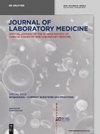长链非编码RNA LINC01060在胃癌中的诊断价值
IF 1.8
4区 医学
Q4 MEDICAL LABORATORY TECHNOLOGY
引用次数: 0
摘要
摘要目的癌症是一种常见的威胁人类健康的胃肠道肿瘤。传统肿瘤标志物的敏感性和特异性已不能满足GC检测的要求。长链非编码RNA(lncRNA)对肿瘤的发展至关重要。因此,在本研究中,将评估LINC01060在GC中的诊断价值。方法采用实时定量聚合酶链式反应(qRT-PCR)测定LINC01060在GC组织和血液样品中的相对表达水平。此外,还分析了LINC01060的表达水平与患者临床病理特征之间的关系。受试者操作特征(ROC)曲线用于评估LINC01060、癌胚抗原(CEA)和碳水化合物抗原19-9(CA19-9)在GC中的诊断功效。结果胃癌组织中LINC01060的表达明显下降(p<0.01),胃癌患者全血中LINC0060的表达水平较消化性溃疡和健康对照组明显下降。此外,在区分GC和健康对照方面,LINC01060表现出比CEA和CA19-9更高的敏感性和特异性(AUC=0.872,敏感性=96.0%,特异性=76.7%)。对于传统生物标志物,CEA和CA19-9的AUC分别为0.715(敏感性=86.0%,特异性=50.0%)和0.634(敏感性=63.0%,特异度=76.0%)。值得注意的是,其他胃肠道肿瘤没有显示出任何统计学上的显著差异。未发现LINC01060的存在与特征性临床病理因素显著相关。结论LINC01060可作为GC诊断和区分GC患者与健康对照的生物标志物。本文章由计算机程序翻译,如有差异,请以英文原文为准。
Diagnostic value of long noncoding RNA LINC01060 in gastric cancer
Abstract Objectives Gastric cancer (GC) is a common gastrointestinal tumor that threatens human health. The sensitivity and specificity of traditional tumor markers do not meet the requirements for detection of GC. Long noncoding RNAs (lncRNAs) are crucial for the development of tumors. Hence, in this study, LINC01060 will be evaluated for its diagnostic value in GC. Methods Quantitative real-time PCR (qRT-PCR) was used to determine the relative expression levels of LINC01060 in GC tissues and blood samples. In addition, the relationship between the expression levels of LINC01060 and the clinicopathological features of the patients was analyzed. Receiver operating characteristic (ROC) curves were utilized to assess the diagnostic efficacy of LINC01060, carcinoembryonic antigen (CEA), and carbohydrate antigen 19-9 (CA19-9) in GC. Results The expression of LINC01060 was found to have decreased in GC tissues (p<0.01). Notably, compared with peptic ulcers and healthy controls, the expression levels of LINC01060 in the whole blood of GC patients was found to have decreased. Furthermore, LINC01060 exhibited higher sensitivity and specificity than CEA and CA19-9 in differentiating GC from healthy controls (AUC=0.872, sensitivity=96.0%, specificity=76.7%). With regard to traditional biomarkers, the AUC of CEA and CA19-9 were 0.715 (sensitivity=86.0%, specificity=50.0%) and 0.634 (sensitivity=63.0%, specificity=76.0%), respectively. Remarkably, the other gastrointestinal tumors did not show any statistically significant differences. The presence of LINC01060 was not found to be significantly associated with characteristic clinicopathological factors. Conclusions LINC01060 might be useful as a biomarker for diagnosing GC and distinguishing GC patients from healthy controls.
求助全文
通过发布文献求助,成功后即可免费获取论文全文。
去求助
来源期刊

Journal of Laboratory Medicine
Mathematics-Discrete Mathematics and Combinatorics
CiteScore
2.50
自引率
0.00%
发文量
39
审稿时长
10 weeks
期刊介绍:
The Journal of Laboratory Medicine (JLM) is a bi-monthly published journal that reports on the latest developments in laboratory medicine. Particular focus is placed on the diagnostic aspects of the clinical laboratory, although technical, regulatory, and educational topics are equally covered. The Journal specializes in the publication of high-standard, competent and timely review articles on clinical, methodological and pathogenic aspects of modern laboratory diagnostics. These reviews are critically reviewed by expert reviewers and JLM’s Associate Editors who are specialists in the various subdisciplines of laboratory medicine. In addition, JLM publishes original research articles, case reports, point/counterpoint articles and letters to the editor, all of which are peer reviewed by at least two experts in the field.
 求助内容:
求助内容: 应助结果提醒方式:
应助结果提醒方式:


